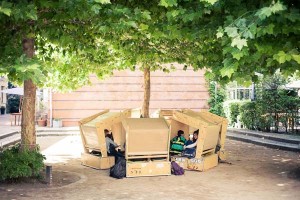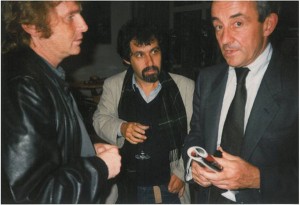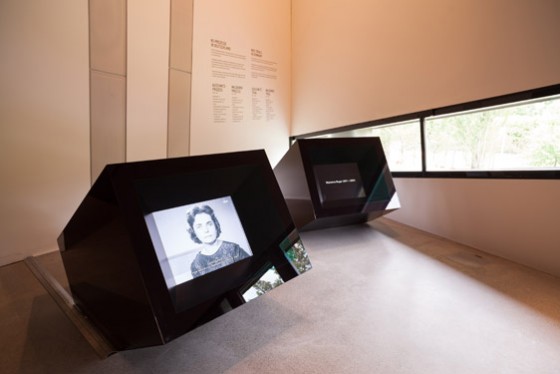
Timber houses in the form of the Hebrew
letter Bet
© The Beit Project, photo: David Gauffin
Beit is the name of a European project thought up by David Stoleru, a Jewish architect from France. The name refers to the Hebrew word for house “Bajit” as well as to the letter “Bet” of the Hebrew alphabet. Stoleru has designed small timber houses that are somewhat reminiscent of the cozy beach basket chairs common on Germany’s Baltic coast. Seen from the side, they resemble the symbol ב for Bet, the first letter of the word beit. Several classes of eighth-graders set up such houses in the Heckmann Höfe in the Mitte district of Berlin, as a means to temporarily bring into the public sphere their nearby school, whose Hebrew name, Beit Sefer, literally means “House of the Book.” Here, for two days, they devoted themselves to the task of uncovering traces of the Jewish community in the local cultural and urban heritage.
It proved to be a strenuous two days’ work, during which the schoolchildren were almost constantly on the go and often had to push themselves to their limits. → continue reading
10 April, 1946 – 9 August, 2012

Ronny Loewy (in the middle) with the director Louis Malle (r.) and Daniel Cohn-Bendit (l.) at the German premiere of “Au revoir les enfants,” 1987, courtesy of Gisela Geier-Loewy
On August 9 of last year, film historian Ronny Loewy died. He was a remarkable person and a friend of this museum, who supported and inspired our work from the beginning: it was Ronny who selected many of the film excerpts that appear in our permanent exhibition or appeared in the special exhibition “Home and Exile”. He also published, among other things, Tereska Torrès’s film diary Unerschrocken: Auf dem Weg nach Palästina (Unafraid: On the Way to Palestine) about the illegal emigration of Displaced Persons to Palestine in 1947 and 48. Ronny was a colleague and friend, with whom we not only worked but also shared many experiences and much laughter, who constantly opened our eyes to the new and unusual, the forgotten and overlooked, little details from films, and above all to the people behind these moving pictures.
We therefore wish to dedicate space on this blog today to remembering him and his life, one year after his death: → continue reading
A New Space for the Auschwitz Trial in the Permanent Exhibition
Last October I wrote a blog post about Memorandum, a Canadian documentary film about the Auschwitz trial in Frankfurt (1963 – 1965). An excerpt of this film has been part of our permanent exhibition for a number of years already. We observed that the film clip elicited a much more intense response from visitors to the legal proceedings of Nazi criminals in Frankfurt than did other forms of media, such as photographs or audio clips. For this reason, documentary film material has been made the central focus of the newly designed area of our permanent exhibition.

“My husband was very accurate, indeed, but […] I can’t imagine all this,” said the wife of Auschwitz perpetrator Wilhelm Boger to NDR journalists
© Jewish Museum Berlin, photo: Alexander Zuckrow
Just a few days ago we re-opened this space with the title “On trial: Auschwitz/Majdanek.” In order to convey how the Auschwitz trial in Frankfurt shaped and changed public attitudes towards the past in Germany, we now show a variety of excerpts from contemporary television coverage. In the international coverage of the trial, groundbreaking questions were raised about the way the National Socialist era was officially and publicly dealt with. → continue reading


